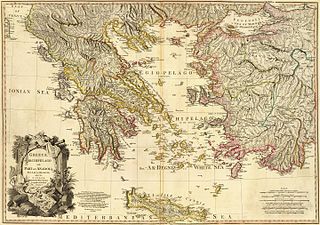 W
WThe history of modern Greece covers the history of Greece from the recognition of its autonomy from the Ottoman Empire by the Great Powers in 1828, after the Greek War of Independence, to the present day.
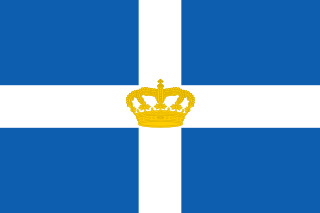 W
WThe Kingdom of Greece was established in 1832 and was the successor state to the First Hellenic Republic. It was internationally recognised by the Treaty of Constantinople, where Greece also secured its full independence from the Ottoman Empire after nearly four centuries.
 W
WThe 4th of August Regime, commonly also known as the Metaxas regime, was a totalitarian regime under the leadership of General Ioannis Metaxas that ruled the Kingdom of Greece from 1936 to 1941. On 4 August 1936, Metaxas, with the support of King George II, suspended the Greek parliament and went on to preside over a conservative, staunchly anti-communist government. The regime took inspiration in its symbolism and rhetoric from Fascist Italy, but retained close links to Britain and the French Third Republic, rather than the Axis powers. Lacking a popular base, after Metaxas' death in January 1941 the regime hinged entirely on the King. Although Greece was occupied following the German invasion of Greece in April 1941 and the Greek government was forced into exile in the British-controlled Kingdom of Egypt, several prominent figures and features of the regime, notably the notorious security chief Konstantinos Maniadakis, survived for several months in cabinet until the King was forced to dismiss them in a compromise with the representatives of the old democratic political establishment.
 W
WThe Balkan Federation project was a left-wing political movement to create a country in the Balkans by combining Yugoslavia, Albania, Greece, Bulgaria, and Romania.
 W
WChameria is a term used today mostly by Albanians for parts of the coastal region of Epirus in southern Albania and the historical Greek region of Epirus, traditionally associated with an Albanian speaking population called Chams. For a brief period (1909-1912), three kazas were combined by the Ottomans into an administrative district called Çamlak sancak. Apart from geographical usages, in contemporary times within Albania the toponym has also acquired irredentist connotations. During the interwar period, the toponym was in common use and the official name of the area above the Acheron river in all Greek state documents. Today it is obsolete in Greek, surviving in some old folk songs. Most of what is called Chameria is divided between the Greek regional units of Thesprotia and Preveza, the southern extremity of Albania's Sarandë District and some villages in eastern Ioannina regional unit. As the Greek toponyms Epirus and Thesprotia have been established for the region since antiquity, and given the negative sentiments towards Albanian irredentism, the term is not used by the locals on the Greek side of the border.
 W
WThe Convention between Italy and Turkey, signed in Ankara on January 4, 1932, by the Italian Plenipotentiary, Ambassador Pompeo Aloisi, and the Turkish foreign minister Tevfik Rüştü Aras, settled a dispute that had arisen in the aftermath of the Treaty of Lausanne of 1923, about the sovereignty over a number of small islets and the delimitation of the territorial waters between the coast of Anatolia and the island of Kastellórizo, which was an Italian possession since 1921.
 W
WThe Cyprus dispute, also known as the Cyprus conflict, Cyprus issue, or Cyprus problem, is an ongoing dispute between Greek Cypriots and Turkish Cypriots. Initially, with the occupation of the island by the British Empire from the Ottoman Empire in 1878 and subsequent annexation in 1914, the "Cyprus dispute" was identified as the conflict between the people of Cyprus and the British Crown regarding the Cypriots' demand for self-determination. The British administration shifted the dispute from a colonial dispute to an ethnic dispute between the Turkish and Greek islanders.
 W
WThe flag of Macedonia represents a Vergina Sun with 16 rays in the centre of a blue field. This flag, as well as the Vergina Sun, is commonly used as an unofficial symbol of the Greek region of Macedonia and its subdivisions. It is also used by organisations of the Greek Macedonian diaspora, such as the Pan-Macedonian Association chapters of the United States and Australia, as well as numerous commercial enterprises and private citizens.
 W
WGhost rockets were rocket- or missile-shaped unidentified flying objects sighted in 1946, mostly in Sweden and nearby countries.
 W
WThe Greek Civil War was fought between the Greek government army and the Democratic Army of Greece (DSE) — the military branch of the Communist Party of Greece (KKE) from 1946 to 1949. The fighting resulted in the defeat of the DSE by the Hellenic Army.
 W
WThe Greek royal family is a branch of the House of Glücksburg that reigned in Greece from 1863 to 1924 and again from 1935 to 1973. Its first monarch was George I, the second son of King Christian IX of Denmark.
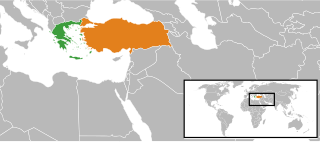 W
WRelations between the Greek and the Turkish states have been marked by alternating periods of mutual hostility and reconciliation ever since Greece won its independence from the Ottoman Empire in 1830. The two countries have faced each other in four major wars—the Greco-Turkish War (1897), the First Balkan War of 1912 to 1913, the First World War and finally the Greco-Turkish War (1919–22), which were followed by the Greco-Turkish population exchange and a period of friendly relations in the 1930s and 1940s. Both countries entered NATO in 1952. Relations deteriorated again after the 1950s due to the 1955 Istanbul pogrom, the Cyprus issue, and the expulsion of the Istanbul Greeks in the 1960s, the 1974 Cypriot coup d'etat, immediately followed by the Turkish invasion of Cyprus in 1974, the Imia/Kardak military crisis in 1996 and subsequent military confrontations over the Aegean dispute. A period of relative normalization began after 1999 with the so-called "earthquake diplomacy", which notably led to a change in the previously firmly negative stance of the Greek government on the issue of the accession of Turkey to the European Union. As of 2020, military tensions have risen again due to conflicts over maritime zones in the Aegean and Eastern Mediterranean.
 W
WThe Hellenic (Greek) Memorial is on Anzac Parade, beside the Australian War Memorial in Canberra, the national capital city of Australia.
 W
WThe history of the Hellenic Republic constitutes three discrete republican periods in the modern history of Greece: from 1822 until 1832; from 1924 until 1935; and from 1974 through to the present. See also the constitutional history of Greece.
 W
WIn the 19th century, the national revival in the Balkans began; national and religious antagonism flared, and conflict was heightened by the Ottoman policy of playing one group against the other. Meanwhile, the Ottoman Empire lost control over the major sections of Greece, Serbia, and Bulgaria, each of which claimed Macedonia on historical or ethnical grounds.
 W
WTurkish: Büyük fikir/ideal.
 W
WModern Greece: A History Since 1821 is a book written by John S. Koliopoulos and Thanos Veremes. This book was first published on 1 January 2009.
 W
WOhi Day or Oxi Day is celebrated throughout Greece, Cyprus and the Greek communities around the world on 28 October each year. Ohi Day commemorates the rejection by Greek Prime Minister Ioannis Metaxas of the ultimatum made by Italian dictator Benito Mussolini on 28 October 1940, the Hellenic counterattack against the invading Italian forces at the mountains of Pindus during the Greco-Italian War, and the Greek Resistance during the Axis occupation.
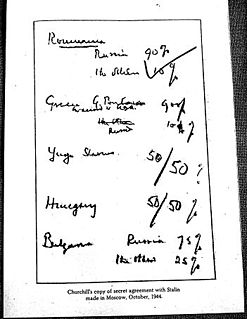 W
WThe Percentages Agreement was a secret informal agreement between British prime minister Winston Churchill and Soviet leader Joseph Stalin during the Fourth Moscow Conference in October 1944. It gave the percentage division of control over Eastern European countries, dividing them into spheres of influence. Franklin Roosevelt was consulted tentatively and conceded to the agreement. The content of the agreement was first made public by Churchill in 1953 in the final volume of his memoir. The US ambassador Averell Harriman, who was supposed to represent Roosevelt in these meetings, was excluded from this discussion.
 W
WThe Second Hellenic Republic is a modern historiographical term used to refer to the Greek state during a period of republican governance between 1924 and 1935. To its contemporaries it was known officially as the Hellenic Republic or more commonly as Greece. It occupied virtually the coterminous territory of modern Greece and bordered Albania, Yugoslavia, Bulgaria, Turkey and the Italian Aegean Islands. The term Second Republic is used to differentiate it from the First and Third republics.
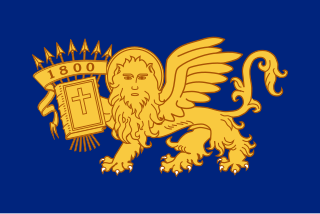 W
WThe Septinsular Republic was an oligarchic republic that existed from 1800 to 1807 under nominal Russian and Ottoman sovereignty in the Ionian Islands.
 W
WEastern Sporades or Eastern Islands was the name of one of the thirteen divisions created in 1828 with the administrative division of the newly formed Hellenic State by the government of Ioannis Kapodistrias.
 W
WThe borders of Greece from the Protocol of London from March 22, 1829 until the accession of the Dodecanese were changed nine times and its territorial extensions were seven.
 W
WThe Treaty of Constantinople was the product of the London Conference of 1832 which opened in February 1832 with the participation of the Great Powers on the one hand and the Ottoman Empire on the other. The factors which shaped the treaty included the refusal of Leopold of Saxe-Coburg-Gotha to assume the Greek throne. He was not at all satisfied with the Aspropotamos–Spercheios line, which replaced the more favorable Arta–Volos line considered by the Great Powers earlier.
 W
WTwice A Stranger: How Mass Expulsion Forged Modern Greece and Turkey is a book by Bruce Clark published in 2006 concerning the population exchange between Greece and Turkey which took place in the early 1920s, following the Treaty of Lausanne.
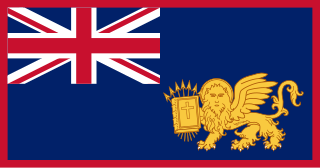 W
WThe United States of the Ionian Islands was a Greek state and amical protectorate of Great Britain between 1815 and 1864. It was the successor state of the Septinsular Republic. It covered the territory of the Ionian Islands, in modern Greece, and it was ceded to Greece as a gift of Britain to the newly enthroned King George I after the Resolution for union with Greece which was proposed by the Party of the Radicals.
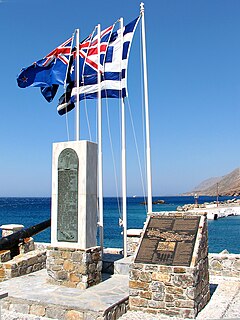 W
WThe military history of Greece during World War II began on 28 October 1940, when the Italian Army invaded from Albania, beginning the Greco-Italian War. The Greek Army was able to halt the invasion temporarily and was able to push the Italians back into Albania. The Greek successes forced Nazi Germany to intervene. The Germans invaded Greece and Yugoslavia on 6 April 1941, and overran both countries within a month, despite British aid to Greece in the form of an expeditionary corps. The conquest of Greece was completed in May with the capture of Crete from the air, although the Fallschirmjäger suffered such extensive casualties in this operation that the Oberkommando der Wehrmacht abandoned large-scale airborne operations for the remainder of the war. The German diversion of resources in the Balkans is also considered by some historians to have delayed the launch of the invasion of the Soviet Union by a critical month, which proved disastrous when the German Army failed to take Moscow.